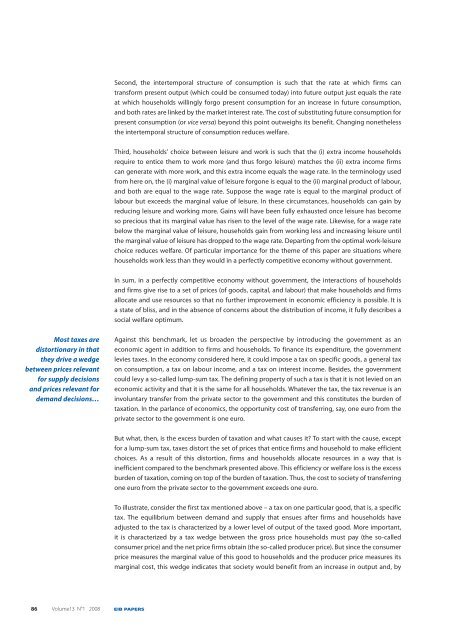EIB Papers Volume 13. n°1/2008 - European Investment Bank
EIB Papers Volume 13. n°1/2008 - European Investment Bank
EIB Papers Volume 13. n°1/2008 - European Investment Bank
You also want an ePaper? Increase the reach of your titles
YUMPU automatically turns print PDFs into web optimized ePapers that Google loves.
Most taxes are<br />
distortionary in that<br />
they drive a wedge<br />
between prices relevant<br />
for supply decisions<br />
and prices relevant for<br />
demand decisions…<br />
86 <strong>Volume</strong>13 N°1 <strong>2008</strong> <strong>EIB</strong> PAPERS<br />
Second, the intertemporal structure of consumption is such that the rate at which firms can<br />
transform present output (which could be consumed today) into future output just equals the rate<br />
at which households willingly forgo present consumption for an increase in future consumption,<br />
and both rates are linked by the market interest rate. The cost of substituting future consumption for<br />
present consumption (or vice versa) beyond this point outweighs its benefit. Changing nonetheless<br />
the intertemporal structure of consumption reduces welfare.<br />
Third, households’ choice between leisure and work is such that the (i) extra income households<br />
require to entice them to work more (and thus forgo leisure) matches the (ii) extra income firms<br />
can generate with more work, and this extra income equals the wage rate. In the terminology used<br />
from here on, the (i) marginal value of leisure forgone is equal to the (ii) marginal product of labour,<br />
and both are equal to the wage rate. Suppose the wage rate is equal to the marginal product of<br />
labour but exceeds the marginal value of leisure. In these circumstances, households can gain by<br />
reducing leisure and working more. Gains will have been fully exhausted once leisure has become<br />
so precious that its marginal value has risen to the level of the wage rate. Likewise, for a wage rate<br />
below the marginal value of leisure, households gain from working less and increasing leisure until<br />
the marginal value of leisure has dropped to the wage rate. Departing from the optimal work-leisure<br />
choice reduces welfare. Of particular importance for the theme of this paper are situations where<br />
households work less than they would in a perfectly competitive economy without government.<br />
In sum, in a perfectly competitive economy without government, the interactions of households<br />
and firms give rise to a set of prices (of goods, capital, and labour) that make households and firms<br />
allocate and use resources so that no further improvement in economic efficiency is possible. It is<br />
a state of bliss, and in the absence of concerns about the distribution of income, it fully describes a<br />
social welfare optimum.<br />
Against this benchmark, let us broaden the perspective by introducing the government as an<br />
economic agent in addition to firms and households. To finance its expenditure, the government<br />
levies taxes. In the economy considered here, it could impose a tax on specific goods, a general tax<br />
on consumption, a tax on labour income, and a tax on interest income. Besides, the government<br />
could levy a so-called lump-sum tax. The defining property of such a tax is that it is not levied on an<br />
economic activity and that it is the same for all households. Whatever the tax, the tax revenue is an<br />
involuntary transfer from the private sector to the government and this constitutes the burden of<br />
taxation. In the parlance of economics, the opportunity cost of transferring, say, one euro from the<br />
private sector to the government is one euro.<br />
But what, then, is the excess burden of taxation and what causes it? To start with the cause, except<br />
for a lump-sum tax, taxes distort the set of prices that entice firms and household to make efficient<br />
choices. As a result of this distortion, firms and households allocate resources in a way that is<br />
inefficient compared to the benchmark presented above. This efficiency or welfare loss is the excess<br />
burden of taxation, coming on top of the burden of taxation. Thus, the cost to society of transferring<br />
one euro from the private sector to the government exceeds one euro.<br />
To illustrate, consider the first tax mentioned above – a tax on one particular good, that is, a specific<br />
tax. The equilibrium between demand and supply that ensues after firms and households have<br />
adjusted to the tax is characterized by a lower level of output of the taxed good. More important,<br />
it is characterized by a tax wedge between the gross price households must pay (the so-called<br />
consumer price) and the net price firms obtain (the so-called producer price). But since the consumer<br />
price measures the marginal value of this good to households and the producer price measures its<br />
marginal cost, this wedge indicates that society would benefit from an increase in output and, by

















